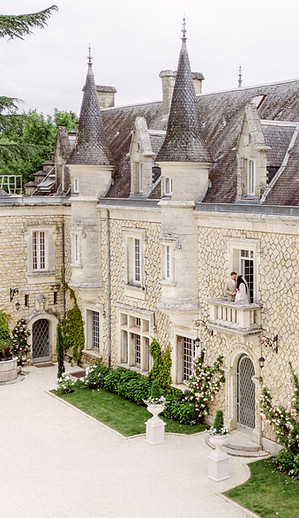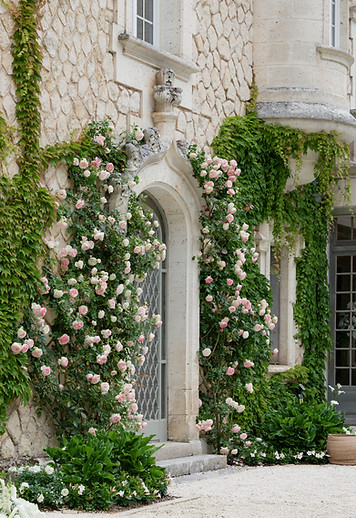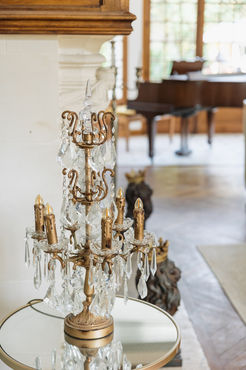Château de la Couronne

The Couronne Estate
AND FIVE ACRES OF GROUNDS
The Château is set within 5 acres of enchanting gardens, featuring fountains, woodlands, and a spacious open area perfect for events or helicopter landings. Highlights include a large swimming pool, a terrace, a courtyard, and a football pitch ideal for various sports activities.
The Château spans three floors. The ground floor includes a variety of rooms to explore, relax, and unwind, with 9 salons. Accommodation is available for up to 50 people, including The Château, The Garden Suite, and The Coach House and Maison de la Couronne
Where luxury meets French Chateau





Venue Features




The Drawing Room
The grand entrance is a breathtaking introduction to the château, featuring a striking 10-foot crystal chandelier cascading from the second-floor balcony. This space is ideal for welcome drinks or can be transformed into an elegant setting for entertaining.
The piano room is a refined social space, complete with a grand piano and bi-folding patio doors that open onto the terrace, seamlessly connecting the indoors with the gardens and swimming pool.
The dining room offers an intimate setting for up to 10 guests, perfect for elegant dinners and gatherings.
The Billiard Room
Styled with rich wooden bookcases and historic photographs, the billiard room exudes a distinguished, gentlemanly charm. A sophisticated space for entertaining, it's also the perfect backdrop for the groom and his groomsmen to capture stylish ‘getting ready’ photos while enjoying a few drinks.




Château Salons
The Chandelier Bar, stocked with premium spirits, local wines, and Champagne from the region, serves as the heart of evening festivities. Accessible from the courtyard, it offers a sophisticated space to gather and celebrate.
The snug, nestled between the banquet hall and the Chandelier Bar, provides a relaxed and intimate setting where guests can unwind and socialize over a leisurely drink. The banquet hall is a spectacular space for special events, featuring soaring ceilings adorned with original wooden beams draped in chiffon. The grand stone walls add a timeless charm, while the maisonette balcony creates the perfect setting for a DJ or live music, ensuring an unforgettable celebration.
The cinema room features a large projector screen with a curated selection of films, offering a cozy retreat for relaxed evenings.
The pantry provides a charming kitchenette-style space, equipped with a kettle, toaster, microwave, and fridge. Complimentary tea, coffee, and water are available, with the option for full stocking upon request.
Couronne Accommodation
SLEEPING UP TO 50 GUESTS
The Château
A comfortable night’s sleep is essential. The Château features nine beautifully refurbished bedrooms, each with king or queen-size beds and air-conditioning. Thoughtful touches in every room include coffee machines, hairdryers, bath and pool towels, and luxury bathing products.
For weddings, with the couple in mind, bedroom amenities also include a mannequin, a freestanding clothes valet, a steamer, and a stylist chair for hair and make-up. The Juliette Suite and Angelina Suite—ideal for bridal preparations—also feature a stocked mini fridge for added convenience.
The Coach House
The Coach House is a quirky yet stylish apartment overlooking the courtyard, offering the grandest view of the Château. The kitchen is fully equipped with an American fridge/freezer, double oven, and all essential cooking appliances. A cosy lounge with a wood burner (perfect for winter evenings!) and a smart TV makes it a great space to relax. The Coach House offers five double bedrooms and two bathrooms, comfortably sleeping up to 10 guests.
The Garden Suite
The Garden Suite opens out into the rear Château gardens, with a terrace perfect for lounging. Inside, it boasts a large log burner and a comfortable seating area. This suite includes two double bedrooms, a wet room with disabled access, and sleeps up to five guests.
Maison de la Couronne
Once the estate’s original gatehouse, it has now been transformed into a stylish five-bedroom property, sleeping up to 10 people. Beautifully furnished with French pieces, chandeliers and shabby-chic mirrors. The house also includes a fully equipped kitchen and three bathrooms.
What People Say About Us
Over the last 2 years, we have seen the Chateau completely transformed and elevated into the luxury destination it is today. Over time, Lucy & Ben became not only vendors, but great friends.
When the big weekend arrived, our guests were absolutely shocked by the beauty of the property, they felt as though they had stepped into a movie set. Each room had been tastefully decorated with a customer-centric focus akin to a 5 star hotel and our guests were treated like royalty.
I am lost for words for the professionalism and care to which we were treated to this weekend. The team worked tirelessly in the background coordinating a sea of vendors and navigating unforeseen external challenges to ensure that our wedding was seamless and magical. This long weekend will forever be the most cherished memories for us and we were so sad to leave!
Emily - June 2025
As featured in




















